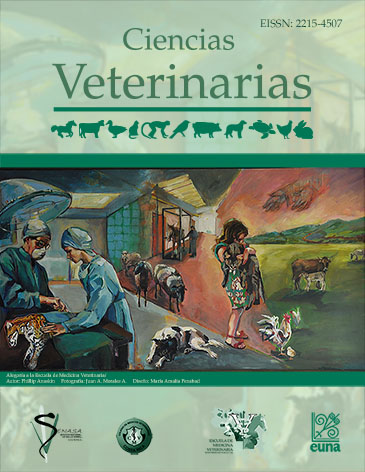Dermatophytic pseudomycetoma in a Persian cat: case report in Costa Rica
DOI:
https://doi.org/10.15359/rcv.38-2.1Keywords:
feline, Persian Cat, itraconazole, Microsporum canis, pseudomycetomaAbstract
The paper describes a case of dermatophytic pseudomycetoma caused by Microsporum canis diagnosed through histopathology with H&E, GMS, and PAS, direct microscopic examination with KOH, and mycological culture in a spayed 5-year-old female Persian feline, with a history of multiple recurrent nontender subcutaneous masses on the back over a year and a half. The subject was treated with Itraconazole for four months, which was suspended due to drug intolerance. Internal organ invasion was discarded by ultrasound and cytology.
References
Bernhardt, A., von Bomhard, W., Aintweiler, E., & Tintelnot, K. 2015. Molecular identification of fungal pathogens in nodular skin lesions of cats. Med. Mycol. 53(2): 132-144. doi: 10.1093/mmy/myu082
Bianchi, M.V., Laisse, C.J.M., Vargas, T.P., Wouters, F., Boabaid, F.M., Pavarini S.P., Ferreiro, L. & Driemeier, D. 2017. Intra-abdominal fungal pseudomycetoma in two cats. Rev. Iberoam. Micol. 32(2): 112-115. doi: 10.1016/j.riam.2016.10.001
Bond, R., Pocknell, A.M. & Toze, C.E. 2001. Pseudomycetoma caused by Microsporum canis in a Persian cat: lack of response to oral terbinafine. J. Small Anim. Pract. 42(11): 557-560. doi: 10.1111/j.1748-5827.2001.tb06028.x
Calderón-Hernández, A, & Urbina-Villalobos, A. 2018. Veterinary mycosis in a tropical country. 20th Congress of the International Society for Human and Animal Mycology. Amsterdam, The Netherlands. Abstract, Med. Mycol. 56: S1-S159. doi: doi.org/10.1093/mmy/myy036
Chang, S.C., Liao, J.W., Shyu, C.L., Hsu, W.L., & Wong, M.L. 2010. Dermatophytic pseudomycetomas in four cats. Vet. Dermatol. 22(2): 181-187. doi: 10.1111/j.1365-3164.2010.00937.x
de Hoog, G.S., Guarro, J., Gené, J. & Figueras, M.J. 2014. Microsporum canis. In: Atlas of clinical fungi: The ultimate bench tool for diagnostics, online version 4.0. Centraalbureau voor Schimmelcultures, Utrecht.
Duangkaew, L., Larsuprom, L., Kasondorkbua, C., Chen, C. & Chindamporn, A. 2017. Cutaneous blastomycosis and dermatophytic pseudomycetoma in a Persian cat from Bangkok, Thailand. Med. Mycol. Case Rep. 15(1): 12-15. doi: 10.1016/j.mmcr.2017.01.001
Goldberg, H. 1965. Brush technique in animals: finding contacts sources of fungus diseases. Arch. Dermatol. 92(1): 103.
Gross, T.L., Ihrke, P.J., Walder, E.J. & Affolter, V.K. (Eds.). 2005. Skin Diseases of the Dog and Cat, 2nd Edition. Blackwell Publishing, Oxford. p 288-291.
Hubka, V., Peano, A., Cmokova, A. & Guillot, J. 2018. Common and emerging dermatophytoses in animals: well-known and new threats. In: Seyedmousavi, S., de Hoog, G.S., Guillot, J., & Vertweij, P.E (Eds.). Emerging and epizootic fungal infections in animals. Springer Nature, Cham. p 31-79. doi: 10.1007/978-3-319-72093-7_3
Kano, R., Edamura, K., Yumikura, H., Maruyama, H., Asano, K., Tanaka, S. & Hasegawa, A. 2008. Confirmed case of feline mycetoma due to Microsporum canis. Mycoses 52(1): 80-83. doi: 10.1111/j.1439-0507.2008.01518.x
Nobre, M., Mueller, E., Tillmann, M., Rosa, C., Guim, T., Vives, P., Fernandes, M., Madrid, I., Fernandes C. & Meireles, M.C. 2010. Disease progression of dermatophytic pseudomycetoma in a Persian cat. Rev. Iberoam. Micol. 27(2): 98-100. doi: 10.1016/j.riam.2009.12.004
Pereira, A., Damico, C., de Souza, H., Corgozinho, K., Graça, R., Paes de Almeida, E. & Ferreira, A.M. 2006. Pseudomicetoma dermatofítico causado por Microsporum canis em gato da raça persa. Acta Sci. Vet. 34(2): 193-196.
Plumb, D.C. 2018a. Itraconazole. In: Plumb’s Veterinary Drug Handbook, 9th Edition. Wiley-Blackwell, New Jersey. p. 642-645.
Plumb, D.C. 2018b. Terbinafine HCl. In: Plumb’s Veterinary Drug Handbook, 9th Edition. Wiley-Blackwell, New Jersey. p. 1117-1119.
Seyedmousavi, S., Wiederhold, N.P., Ebel, F., Hedayati, M.T., Rafati, H. & Verweij, P.E. 2018. Antifungal use in veterinary practice and emergence of resistance. In: Seyedmousavi, S., de Hoog, G.S., Guillot, J. & Vertweij, P.E (Eds.). Emerging and epizootic fungal infections in animals. Springer Nature, Cham. p 359-402. doi: 10.1007/978-3-319-72093-7_16
Sousa Filho, R.P. de, Sampaio, K. de O., Alves, M.A.A., Nogueira, D.A.D., Viana, D. de A., de Cunha, M. G.M.C., & da Silva, T.F.P. 2017. Pseudomicetoma dermatofítico disseminado em um gato persa – relato de caso. Arq. Ciênc. Vet. Zool. 20(1): 29-33. doi: 10.25110/arqvet.v20i1.2017.6317
Stanley, S.W., Fischetti, A.J. & Jensen, H.E. 2008. Imaging diagnosis – sublumbar pseudomycetoma in a Persian cat. Vet. Radiol. Ultrasoun. 49(2): 176-178. doi: 10.1111/j.1740-8261.2008.00346.x
Tostes, R.A. & Giuffrida, R. 2003. Pseudomicetoma dermatofítico em felinos. Ciênc. Rural. 33(2): 363-365.
Walsh, T.J., Hayden, R.T., & Larone, D.H. 2018a. Microsporum canis. In: Larone’s Medically Important Fungi: A guide to identification, 6th Edition. ASM Press, Washington D.C. p. 262.
Walsh, T.J., Hayden, R.T. & Larone, D.H. 2018b. Stains. In: Larone’s Medically Important Fungi: A guide to identification, 6th Edition. ASM Press, Washington D.C. p. 27-28.
Published
How to Cite
Issue
Section
License
Licensing of articles
All articles will be published under a license:

Licencia Creative Commons Atribución-NoComercial-SinDerivadas 3.0 Costa Rica.
Access to this journal is free of charge, only the article and the journal must be cited in full.
Intellectual property rights belong to the author. Once the article has been accepted for publication, the author assigns the reproduction rights to the Journal.
Ciencias Veterinarias Journal authorizes the printing of articles and photocopies for personal use. Also, the use for educational purposes is encouraged. Especially: institutions may create links to specific articles found in the journal's server in order to make up course packages, seminars or as instructional material.
The author may place a copy of the final version on his or her server, although it is recommended that a link be maintained to the journal's server where the original article is located.
Intellectual property violations are the responsibility of the author. The company or institution that provides access to the contents, either because it acts only as a transmitter of information (for example, Internet access providers) or because it offers public server services, is not responsible.







